1 Introduction
According to the traditional view that goes back to Stalnaker (Reference Stalnaker and Cole1978), participants in a conversation become part of a cooperative process in which they continuously exchange information by negotiating the propositions that should be included within their Common Ground. The plain propositional content of each sentence, however, may be further “structured” in accordance with the dynamics of the discourse (Chafe, Reference Chafe and Li1976; Halliday, Reference Halliday1967). In this way, speakers try to facilitate a coherent integration of new information within the preexisting set of propositions that are already part of the Common Ground. The informative content of a sentence can be structured at different levels: in some languages, this is expressed through variations in the metrical grid alone; in others, the grammaticalization of categories such as Topic or Focus triggers a re-organization of the constituent order. This is the case of many Romance varieties, in which [+ Topic] or [+Focus] are syntactically active features that may trigger movement to dedicated positions at the edge of the clause. Also in language development, a growing body of evidence indicates that children start to grammaticalize Information Structure (IS) features from early on: soon after entering the two-word stage, young Romance speakers can front verbal complements that would normally appear to the right of the lexical verb, and many of these constructions seem to be genuine cases of Topic or Focus fronting. Clitic Left Dislocations (ClLD) and Wh- questions are perhaps the clearest cases, for the IS-status of the fronted constituent is signaled by distinctive morpho-syntactic signatures.
In ClLDs, the fronted Topic is resumed by a co-indexed clitic pronoun with the same grammatical feature specification. Examples of early ClLD in Catalan and Spanish are reported in (1a-b) below, taken from Grinstead (Reference Grinstead2004)Footnote 1:

In the examples above, the indirect (1a) and the direct object (1b) are fronted and coindexed with a clitic pronoun. At around the same age, and even earlier, subject topicalization is also documented, indicating that topic fronting can involve different verbal arguments (see De Cat, Reference De Cat2007; Jourdain, Reference Jourdain2020 for French; Soares, Reference Soares2006 for Portuguese). By the age of four, ClLD can also be successfully elicited. Belletti and Manetti (Reference Belletti and Manetti2019) showed that Italian children made large use of adult-like ClLDs under appropriate discursive conditions, confirming that at this age ClLD constructions have become entirely productive.
Focus fronting is instead documented by wh-interrogative sentences, under the view that wh-movement is a particular case of focus movement. Children start asking questions by applying wh-movement already at age 2, and this has been reported in a variety of different languages (Dutch: Haegeman, Reference Haegeman1995; German: Clahsen et al., Reference Clahsen, Kursawe and Penke1995; Portuguese: Soares, Reference Soares2003; Norwegian: Westergaard, Reference Westergaard2009; Italian: Moscati & Rizzi, Reference Moscati and Rizzi2021; Catalan: Grinstead, Reference Grinstead2004). A few examples taken from Italian and available on CHILDES (MacWhinney, Reference MacWhinney2000) are given below:

A further issue, central to this paper, concerns children’s ability to encode more articulated discourse-representations, so as to produce sentences with a sequence of left-dislocated constituents. This has been investigated in Moscati and Rizzi (Reference Moscati and Rizzi2021). They looked at the acquisition of the Italian left-periphery, a set of functional projections schematically illustrated in (3)Footnote 2, that are the landing sites for focus and topic(s) movement:

Their corpus analysis, carried on the spontaneous productions of 11 children available on CHILDES, showed that children may activate both the Topic and the Focus position at the same time, as in the example reported in (4):

In (4), the Wh-object is fronted to the left of the verb and it is preceded by the subject. This results in a perfectly grammatical sentence. Assuming that (4) is derived from the underlying SVO order, the existence of this kind of constructions suggests that multiple movements are already available to young children. This conclusion is further supported by the fact that Italian does not seem to be an isolated case, and that similar constructions have been also attested in early PortugueseFootnote 3 (Soares, Reference Soares2006).
Despite their capacity to dislocate more than one constituent in left-peripheral positions, however, something seems to still be missing: whereas there are many examples of Subject > Wh-complement sequences similar to (4), other constructions that would be fully grammatical in the target grammar are instead unattested, at least within the transcription of spontaneous production analyzed in Moscati and Rizzi (Reference Moscati and Rizzi2021). In fact, cases in which a complement precedes the Wh-subject, as in the example (5), are totally absent:

The observation that emerges from spontaneous production is that two left-dislocated constituents invariably follow a rigid ordering. On the bases of the preliminary, and still limited, evidence available, the following descriptive generalization seems to hold for Italian:
This captures the fact that, at a given developmental stage, early sentences with two left-dislocated constituents only allow the Subject > Complement sequence. One goal of this paper is to test the validity of this observation also in comprehension: if the constraints that favor (4) over (5) only gradually weaken, an analogous parsing preference could persist also in older children and it could be visible under a controlled experimental setting.
The second goal of this study is to explore the possible reasons behind the ordering restriction expressed in (6). Why the constituent that occupies the lower position prior to movement cannot cross the other, if this latter is also moved to the left-periphery? In other words, we may ask why the configuration in (7a) is productive, while the alternative in (7b) is not:

As for the absence of post-focal topics in wh-sentences, this is expected since children adhere from early on to a syntactic requirement that forces wh- elements in FocusP to be adjacent to the verb so that no other constituent, topics included, may intervene between them (Guasti, Reference Guasti, Friedemann and Rizzi2000; Moscati & Rizzi, Reference Moscati and Rizzi2021)Footnote 4. However, nothing would prevent a topicalized object (or any other verbal complement) to precede a subject Wh-, as in (5). That is, the configuration represented in (7b). This kind of sentence would be perfectly grammatical in the target language; nonetheless it is unattested in the earliest transcripts. This might not be accidental, also in light of a somehow similar asymmetry found in languages that allow multiple wh-frontings. A well-known example is given by Bulgarian. Here, the order of Wh-elements obeys to a rather rigid order and the final sequence of wh-elements reflects the ordering of constituents in absence of movement (Bošković, Reference Bošković2002; Rudin, Reference Rudin1988). This situation presents striking similarities with the generalization in (6). Consider the contrast in (8a-b). It illustrates the fact that, while a subject wh- can precede the object as in (8a), the alternative ordering is ungrammatical (8b):

It is interesting to notice that the configuration in the ungrammatical (8b) is similar to (7b). Ever since the original observation that goes back to Kuno and Robinson (Reference Kuno and Robinson1972), several attempts have been made to subsume these kinds of superiority effects under other principles (Chomsky, Reference Chomsky, Anderson and Kiparsky1973; Bošković, Reference Bošković1997, Reference Bošković2002; Richards, Reference Richards1997). A recent proposal, presented in Krapova and Cinque (Reference Krapova and Cinque2008), is to make them follow from Relativized Minimality violations (Rizzi, Reference Rizzi1990), with the additional assumption that only a whole chain counts as an “intervener”. Hence, only a nested chain as in (8b) would block movement. We can follow this path and try to reconduct the absence of (7b) in Child Italian to a constraint that impedes a constituent to cross a whole movement chain.
An important difference between (7b) and (8b), however, is that movements in (7b) are triggered by distinct features. The question is why children would, for some time, still not allow nested dependencies even when they are qualified by a different featural specification and allowed in the target grammar. In this respect, it is possible that children and adults differ in their tolerance to the degree of featural overlap between the two moved constituents, as indicated by a bulk of studies on relative clauses (a.o. Adani, Reference Adani2011; Arosio et al., Reference Arosio, Adani, Guasti, Brucart, Gavarró and Solà2009; Friedmann et al., Reference Friedmann, Belletti and Rizzi2009, Belletti et al., Reference Belletti, Friedmann, Brunato and Rizzi2012, Bentea & Durrleman, Reference Bentea, Durrleman, Bril, Coene, Ihsane, Sleeman and Westveer2022).
The paper presents the results of a series of three experiments, designed to test the accessibility of configurations as in (7a-b) under controlled experimental conditions. Children will be presented with sentences in which the two arguments of a transitive verb both appear in sentence-initial position i.e. DP1 DP2 V. If the general advantage for configurations as in (7a), suggested by spontaneous production, is also visible in comprehension, Subject-Object interpretations should be more readily available than Object-Subject readings. Moreover, number dissimilarities between DP1 and DP2 are also expected to improve, at least in part, children’s performance, in line with previous results coming from relative clauses. A further open question concerns the role played by the IS features [+Topic] and [+Focus] to escape intervention. The IS features associated to the two fronted DPs will be manipulated between Experiment 1 and Experiment 2. Finally, the last experiment (Experiment 3) addresses a potential confound related to the alleged difficulties introduced by the insertion of a clitic pronoun.
2 Experiment 1
The first experiment was designed to establish whether a pattern similar to the one found in spontaneous production also emerges in comprehension a few years later, once the target sentences can be tested within an articulated dialogical exchange. Intervention effects potentially generated by multiple left-dislocations were tested using declarative sentences with Corrective focus instead of wh-movement. This permits to invert the position of the two arguments (SO/OS) and to manipulate their number features (sing/plur). The test sentences were strings with two sentence-initial DPs compatible with both a SOV or a OSV interpretation:

The configuration in (9a) is structurally very similar to the early sentences with two-left dislocations produced by children, while (9b) introduces a nested dependency. If crossed dependencies are the ones that do not count as interveners, (9a) should be favored over (9b).
As for the left-peripheral positions occupied by the two fronted constituents, in Experiment 1 the object was correctively focused, so as to express a contrast across utterances (Gussenhoven, Reference Gussenhoven, Lee, Gordon and Büring2008). In Italian, this kind of focus can be either realized in situ or left-dislocated in the same position of Wh-elements. For the specific case of corrective-focus interpretation, Bianchi et al. (Reference Bianchi, Bocci, Cruschina, Aboh, Schaeffer and Sleeman2015) showed, in a controlled judgment task, that both options are equally acceptable for adults.
With respect to the second left-dislocated constituent, a corrective focus can be preceded by a higher topic, just like a Wh-fronted constituent. Unlike the latter, however, corrective-focused constituents do not require adjacency with the finite verb, so that lower topics are also allowed. This makes it possible to place the subject either in a high pre-focal topic position (9a) or in a low post-focal topic position (9b).
In experiment 1, children were tested with sentences that follow the general configurations in (9), within a context where the IS status of the two dislocated constituents was controlled. The experimental set-up was designed so as to make them sound as natural as possible under the appropriate discourse-pragmatic conditions. The target sentences were presented within a short dialogue between two speakers in which one of them corrected what the other just said. This procedure is similar to the one used to investigate children’s semantic-pragmatic competence (a.o. Gualmini et al., Reference Gualmini, Hulsey, Hacquard and Fox2008; Moscati, Reference Moscati, Meibauer and Steinbach2011). Below, an experimental trial is presented. The trial begins with a brief narration, in which the experimenter provides the background with the help of a sequence of pictures on screen. An example of the background story is reported in (10):

At the end of the story, the outcome stayed on screen and two characters appeared. At this point, they start a brief dialogue. This is illustrated in Figure 1.

Figure 1. Example of the visual display showing the story’s outcome and the final dialogue. Capital letters indicate Speaker’s 2 correction on the previous utterance’s object.
Let’s consider the structure of the final dialogue in more detail. Speaker 1 (the Alien) is the first to comment what happened, and he always provided a false description as in (11). Speaker 2 (Pinocchio) then refuses to add the proposition expressed by (11) to the Common Ground and he corrects Speaker 1 by focusing the object and activating the correct alternative. The position of the contrastive focused object is realized before or after the topical subject, as illustrated by sentences (12a) and (12b) that represent two different experimental conditions:

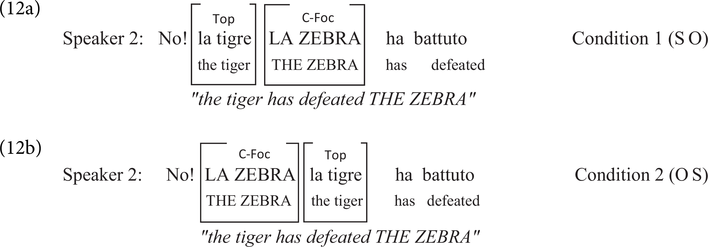
Both sentences (12a and 12b) have the same truth-conditional meaning, as indicated by the English translation. The only difference is in the constituents’ ordering. The structure of the dialogue was built so that Speaker 2 always reprised the same subject of Speaker 1 utterance in (11) (i.e. the Tiger) that served as the discourse topic, while the object conveyed the key contrast between the two utterances. In this way, the exchange provides enough contextual information to determine the syntactic role and the information structure status of the two constituents.
Sentential prosody was also controlled. Prosodic prominence is generally assigned to the constituent in focus (Focus to Stress Alignment, Jackendoff, Reference Jackendoff1972) and the element marked with the feature [+Focus] in the syntactic tree is also aligned with the constituent bearing main prominence in the prosodic tree (Nespor & Guasti, Reference Nespor and Guasti2002). Italian makes no exception and Corrective Focused constituents also receive prosodic prominence, indicated in our examples by capital letters. In the experimental materials, it was expressed by a distinctive raising contour (a L+H* pitch accent) on that constituent (Bianchi et al., Reference Bianchi, Bocci, Cruschina, Aboh, Schaeffer and Sleeman2015). This represents an additional cue that children may exploit to determine the structure of the target sentences. Recent studies in comprehension (Japanese: Ito et al., Reference Ito, Jincho, Minai, Yamane and Mazuka2012; English: Ito et al., Reference Ito, Bibyk, Wagner and Speer2014; Russian: Sekerina & Trueswell, Reference Sekerina and Trueswell2012) indicate that focus prosody is associated with the activation of alternatives in preschoolers and this is already visible by the age of 3 (see Szendrői et al., Reference Szendrői, Bernard, Berger, Gervain and Höhle2018)Footnote 5. To check the prosodic properties of the target sentences, all items were recorded and analyzed in Praat (Boersma & Weenink, Reference Boersma and Weenink2021) so that the objects always received the raising L+H* pitch accent associated with Corrective Focus. Figure 2 and 3 illustrate the pitch contour for sentences (12a) and (12b), with the raising pitch associated with the focused constituent in the second or in the first position respectively, with destressing of the following sentential material.
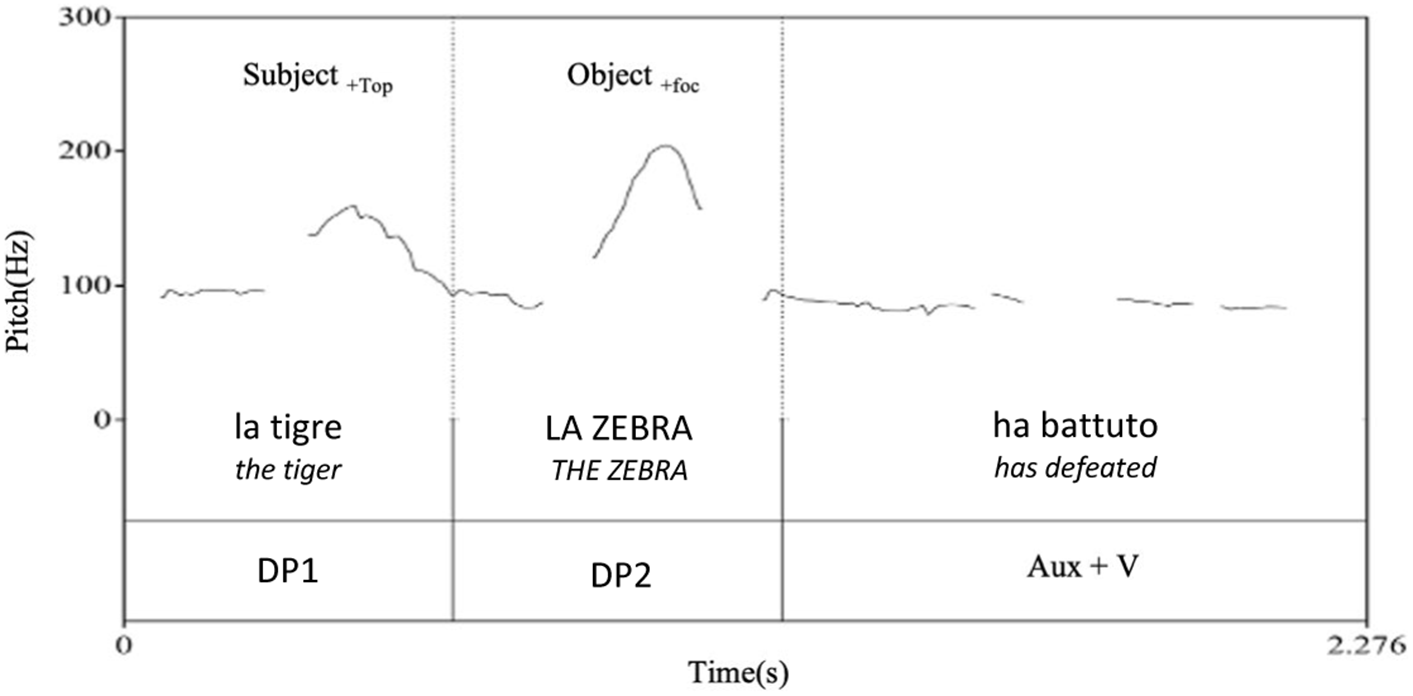
Figure 2. Pitch accents in the SO condition. The Corrective Focus raising pitch is on DP2.

Figure 3. Pitch accents in the OS condition. The Corrective Focus raising pitch is on DP1.
2.1 Design
The first experimental manipulation was on the position of the focused object, resulting in the SO or OS word orders. In addition to this, a mismatch in number was also introduced to further differentiate the subject and the object. In half of the target sentences, both constituents were singular, as in Condition 1 and 2 in (12a-b). In the other half, the subject was instead plural so as to introduce a number mismatch, as in Condition 3 and 4 in (13a-b):
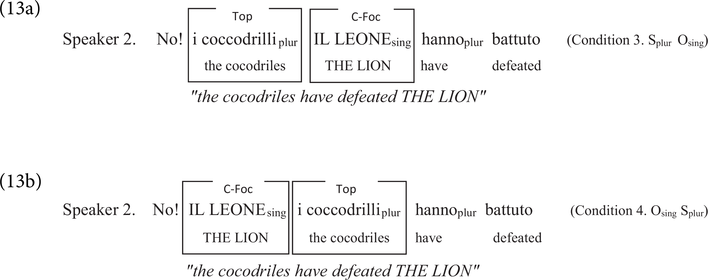
The number manipulation is expected to reduce intervention effects and it would help children to identify the grammatical function of the fronted constituents, since the auxiliary agrees in number with the subject but not with the object. The experimental design was a 2 (Constituent Order) x 2 (Number Mismatch), resulting in the four experimental conditions summarized in Table 1. Information structure associated with the two constituents was kept constant accross the four conditions, so that the object was always the focused constituent (see Supplementary material, Appendix A for the full list of test sentences).
Table 1. Experimental conditions in Experiment 1

2.2 Methods and Materials
Participants were tested in a quiet room in their kindergarten or at the University of Siena. After a short presentation, the experimenter invited the subject to sit in front of a computer screen and listen to a series of stories. Participants were told that they had to pay attention to what happens and to a dialogue between two speakers, in which the second corrected the first. They had to say whether the correction was appropriate or not. The session lasted approximately 20 minutes and it started with a simple task based on naming. This served to familiarize participants with the procedure and the dialogues, making it clear that they had to judge the corrections from Speaker 2 (Pinocchio) in reaction to Speaker 1 (a little alien). In this warm-up, Speaker 1 just saw the picture of an animal (e.g. a cat) and it always named it incorrectly (e.g. “it’s a dog”). Speaker 2 then appeared on screen and corrected Speaker 1, re-naming the animal either correctly “No! It’s a cat” or incorrectly again “No! it’s a cow”. Each participant saw six familiarization trials (3 right corrections, 3 wrong corrections).
The experimental session continued later with two additional warm-up stories in which Speaker 2 always used a canonical SVO sentence, with the focused object stressed and in situ, to correct the alien. At the end of the warm up, participants were presented with four trials for each experimental condition. This resulted in 16 target sentences. Other 4 stories were instead followed by canonical SVO corrections, that served as controls to ensure that participants understood the task. In total, each participants heard 20 stories. True and false Speaker’s 2 sentences were counterbalanced, so that in half of the cases Pinocchio’s corrections were true descriptions of the final outcome of the story and in the other half they were not. The 20 stories were randomized and 4 additional simple naming items, similar to the ones used in the warm-up, were interspersed between them. To be sure that participants paid enough attention to the stories and the dialogues, the experimenter often asked questions about the final outcome (e.g. Who was the winner? Who was the last one?).
2.3 Participants
Children were all recruited within the same area, in the urban district of Florence. 21 five-year-old children (M= 5;8, range= 5;2-5;11) took part in the experiment. The adult control group included 18 adults between 24 and 30 y.o. coming from the same area.
2.4 Results
The majority of children had little trouble in understanding the task and all of them completed the session. However, results from three children were excluded because they didn’t pay full attention to the narrations and to the pictures on screen. Their performance was already poor in the warm-up: two of them answered incorrectly to both SVO sentences and one answered randomly to the initial naming task. A participant from the adult group was also excluded because she did not carry on the whole session till the end. The remaining participants, 18 children and 17 adults showed no general difficulties with the task. In general, children easily understood that they had to judge Speaker 2’s sentence, the final utterance in the dialogues. This is clearly shown by the high rate of correct judgments in SVO control sentences: none of the 18 children gave more than one wrong judgment for SVO sentences and the overall proportion of correct judgments for SVO sentences in the children group was 94.4%. Adults were at ceiling and the performance of both groups is reported in Figure 4.

Figure 4. Experiment 1. Proportion of correct judgments for control SVO sentences in the adult and in the child group.
We consider now the performance of the participants in the four experimental conditions, starting from the adult controls. Figure 5 reports the mean rate of correct answers for OSV and SOV sentences. The solid black line represents the conditions (Condition 1 and 2) with the same number specification for the two fronted constituents (no mismatch); the dashed gray line indicates instead the rate of correct answers with a number mismatch (Conditions 3 and 4).
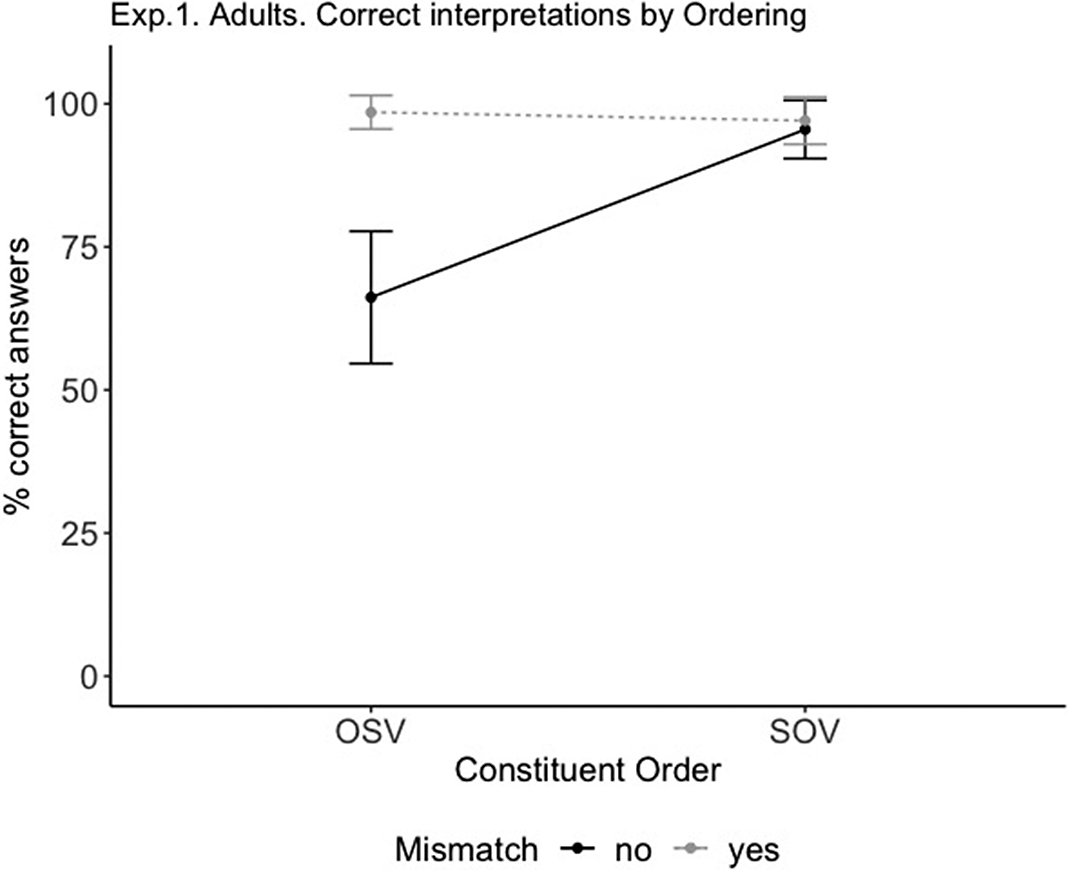
Figure 5. Experiment 1. Adults: Rate of correct judgments in relation to constituent order and number mismatch.
Figure 5 shows that the adults’ performance sensibly varies in function of the constituent order in the conditions without number mismatch, that is when both the subject and the object had the same number specification. When the two fronted DPs are both singular, the proportion of correct judgments raises from 64.7% in the OSV condition to 95.5% in the SOV condition. The asymmetry between OSV and SOV however vanishes once a feature mismatch is introduced. The dashed line shows that the effect of constituent order now disappears: the percentage of correct answers is 98.5% in OSV sentences, very similar and even slightly higher than 97% found in SOV sentences.
To assess the effects of Constituent Order and Number Mismatch, a generalized mixed model was run on the adult data, using the glmer function (lme4 package v.1.1-21, Bates et al., Reference Bates, Maechler, Bolker and Walker2015) in R (R Core Team, 2022). Constituent Order and Number Mismatch were the predictors, or fixed effects, and Subject and Item were included within the model as random effects. The outcome is reported in Table 2.
Table 2. Adults. Estimates of the fixed effects of Constituent Order and Mismatch from mixed effect logistic regression fit by maximum likelihood

◦ Correct ~ WO * Mismatch + (1 | Item) + (1 | Subject). AIC = 150.8; BIC = 172.4; LogLik = -69.4, Deviance = 138.8.
The model revealed a main effect of Constituent Order and Number Mismatch and also a significant interaction. This confirmed that the probability of providing a correct judgment was higher in the SOV than in the OSV condition and that the amelioration due to Mismatch is visible in the more problematic OSV but not in the SOV condition, where adults’ performance is nearly at ceiling.
In the child group, the proportion of correct answers was generally lower. Nevertheless, the overall pattern is not very different from the adult one. In Figure 6, the rate of correct answers is reported for both constituent orders, again with and without number mismatch.
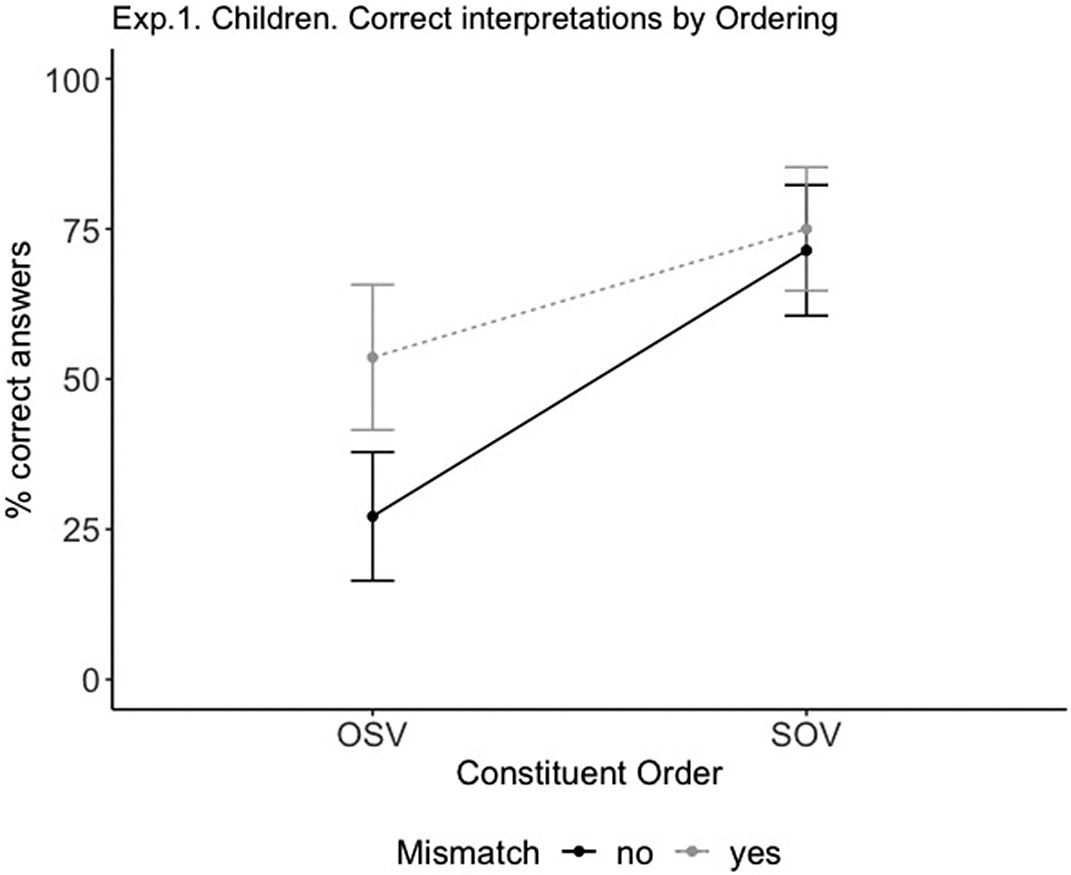
Figure 6. Experiment 1. Children: Rate of correct judgments in relation to constituent order and number mismatch.
Looking at the solid line – that is, the conditions without number mismatch (Condition 1 and 2) – a much higher proportion of correct answers in SOV sentences is visible also in children. They provided the correct judgment only in 27.1% of cases in OSV sentences, while this rate raises to 71.4% in SOV sentences. As in the adult group, however, the introduction of a number mismatch ameliorated children’s performance in OSV sentences. With the number mismatch, the OSV sentences reached 53.6%, while the effect of a number mismatch was minimal for SOV sentences, that slightly grows to 75%.
The same model employed for analyzing adults’ data was also used to assess the effect of Constituent Order and Number Mismatch in children. The model confirmed a significant main effect of Constituent Order and Number Mismatch, while the interaction was only marginally significant (Table 3).
Table 3. Children. Estimates of the fixed effects of Constituent Order and Mismatch from mixed effect logistic regression fit by maximum likelihood

◦ Correct ~ WO * Mismatch + (1 | Item) + (1 | Subject). AIC = 340.7; BIC = 362.6; LogLik = -164.4, Deviance = 328.7.
Children’s results are in line with the adult controls. In both groups, the main effects of Word Order and Mismatch are confirmed. SOV sentences were easier to understand than OSV sentences and a number mismatch between the two frontend DPs also improved performance, with the effect of mismatch being (marginally) higher in the most difficult OSV condition.
2.5 Discussion
The first experiment showed that the order of the two sentence-initial arguments has an impact on children’s and adults’ ability to correctly parse and interpret the sentences. If the two fronted NPs bear the same grammatical feature specification of number, SOV configurations show a sharp advantage over OSV sentences. In Experiment 1 the information status of the two constituents was controlled so that the subject was always topical. Therefore, to be fully explicit, the observed advantage is for STop OC-Foc constructions. Interestingly, this result resembles the pattern found in spontaneous production: while in the earliest multiple left-dislocations the subject may precede a (Wh-) verbal complement, the inverse pattern is virtually absent; and sequences like Otop SWh/Foc are unattested. The results of Experiment 1 are consistent with this observation, modulo the focal status of the object, a point further addressed in experiment 2. This indicates that, also in comprehension and a few years later, children have troubles in parsing sentences in which the object moves across the subject. This kind of superiority-like effect is also modulated in function of the degree of grammatical similarity between the two constituents. In fact, a number mismatch led to an improvement, an effect that is expected under an intervention account.
Adult controls show a similar behavior. Although they are at ceiling in OSV and SOV sentences when they differ in their number features, an advantage for the SOV interpretation is nevertheless observable when the two constituents are both singular. This shows a substantial continuity between the two groups.
This result needs to be also considered with respect to the IS status of the two constituents and the left-peripheral position they occupy. Both children and adults have less troubles in parsing sentences in which the first constituent has a topical status. It is therefore possible that the activation of the high topic position facilitates the comprehension task.
We assumed so far that Topic positions are in free recursion both above and below Focus. Fine-grained syntactic and semantic differences may however exist between low and high topic positions (Frascarelli & Hinterhölzl, Reference Frascarelli, Hinterhölzl, Winkler and Schwabe2007). The low position may be in fact subject to further restrictions. Belletti (Reference Belletti and Rizzi2004) and Benincà and Poletto (Reference Benincà, Poletto and Rizzi2004) suggest that this low position is available only upon the activation of a higher focus, being in this sense “parasitic” on it. Since low topics were invariably preceded by a higher focus, this licensing condition was met by the test items.
We may however also consider IS as an additional factor that impacts the observed advantage for the STopOC-FocV conditions, those configurations in which the highest constituent was marked by a [+Topic] feature. We cannot exclude that this was due to some kind of topic-first bias (Clark & Haviland, Reference Clark and Haviland1977). Since in Experiment 1, subjecthood and topicality were confounded, so that subjects always occupied the highest topic position, in Experiment 2 subjecthood and topicality were split, so that the [+Topic] feature was assigned to the object. In this way, we can assess if the advantage for SOV structures in Experiment 1 can be reduced to the different IS status of the fronted constituents.
3 Experiment 2
The same dialogues-after-stories procedure was employed and the only difference between Experiment 1 and 2 is that in this second experiment the object served as the discourse topic. Now Speaker 2 reprises the same object used in the preceding Speaker 1’s sentence; on the contrary, the new information in focus is associated with the subject. This way, the association between the grammatical function and the IS status of the two sentence-initial constituents is reversed with respect to Experiment 1. If in Experiment 1 STopOC-Foc preferences as in (14) could be explained either by an intervention-based account or by a topic-first bias, in Experiment 2 a topic-first account would now predict that OTopS C-Foc configurations as in (15) would be unproblematic.

3.1 Methods and Materials
The same procedure of Experiment 1 was employed. Again, Speaker 2 provided a correction in response to Speaker 1. This time Speaker 2’s corrections were on the subject that was correctively focused (the GIRAFFE). Speaker’s 2 utterance also reprised the same object that was given (the tiger) in the immediately preceding utterance. This is illustrated in Figure 7:
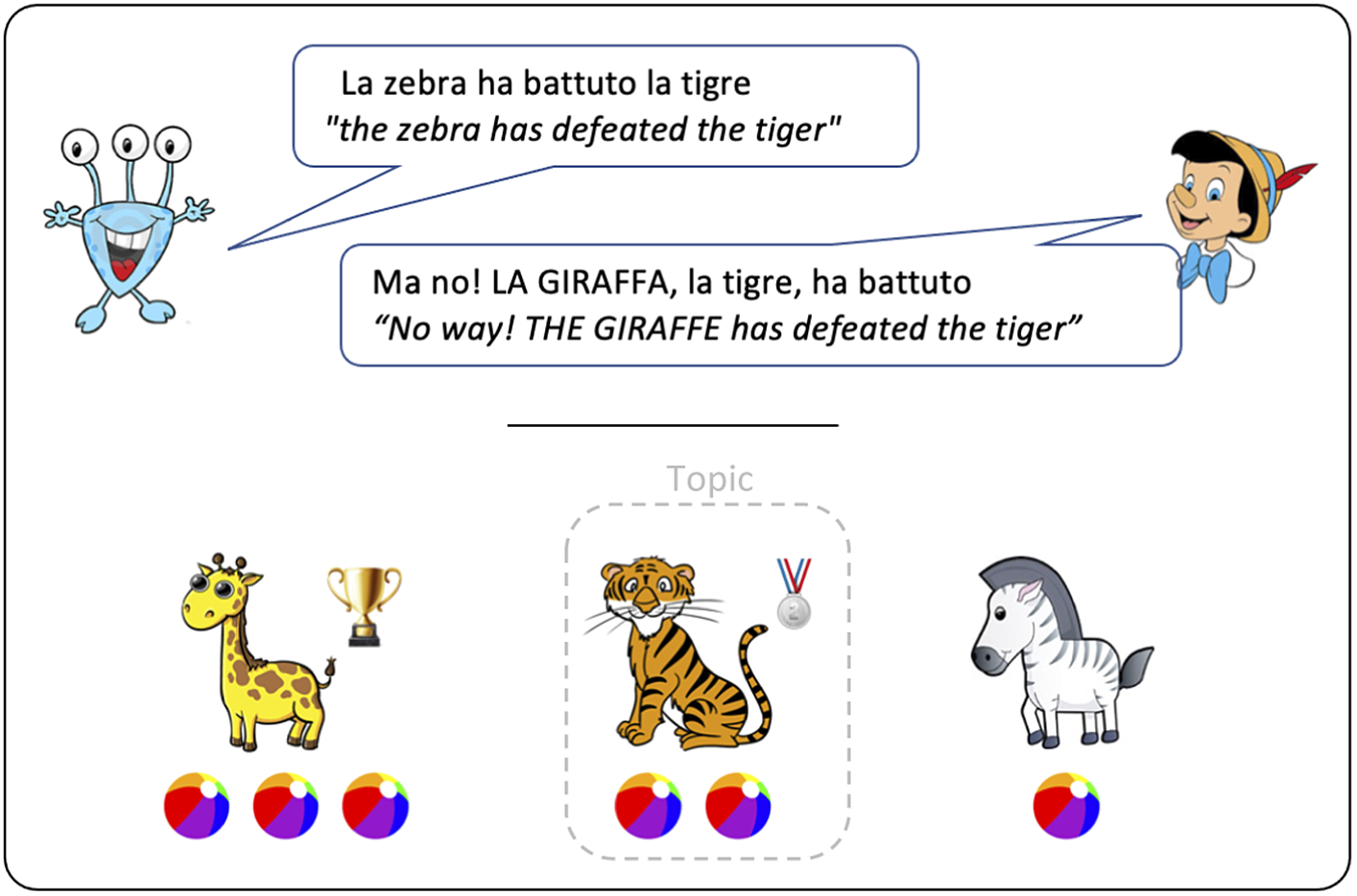
Figure 7. A story outcome in Experiment 2. Capital letters indicate Speaker’s 2 correction; in Experiment 2 this is on the subject of the previous utterance.
Also in Experiment 2, both topic and focus appeared in sentence-initial position and the focused subject could either precede or follow the topical object, as in Condition 1 and 2 in (17a-b)

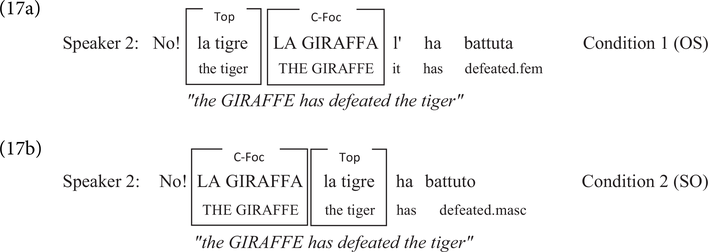
In (17a) the object occupies the highest topic position over focus and it is accompanied by a resumptive clitic that agrees with the past-participle. In (17b) instead the object occupies a lower topic position and the presence of a resumptive clitic here is subject to a certain degree of optionality: for at least some speakers of Italian, a resumptive clitic would result in a degradation of grammaticality (Belletti, Reference Belletti and Rizzi2004; Samek-Lodovici, Reference Samek-Lodovici2006). For this reason, no clitic is present in the SO conditions in which the topic occupies the post-focal position as in (17b). We will come back to this issue later (Experiment 3).
As in Experiment 1, subjects could be either singular or plural, so as to introduce a number-feature mismatch. The manipulations were again on Constituent Order (OS, SO) and on Number Mismatch (sing/sing, sing/plur). The four experimental conditions are reported in Table 4:
Table 4. Experimental conditions of Experiment 2

The experimental session paralleled the one described for Experiment 1, with an initial familiarization based on naming and followed by two warm-up stories in which Speaker 2 used a SVO canonical sentence. Later, participants heard a total of 20 sentences: 4 SVO controls and 16 target sentences, 4 for each condition in Table 4 (see Supplementary material, Appendix B for the full list of test sentences).
3.2 Participants
23 children (M= 5;9. Range 5;6 – 6;2) and 18 adults between 24 and 30 y.o were recruited in the same area of Experiment 1. None of them took part in Experiment 1.
3.3 Results
Five participants in the child group were excluded under the same criteria of Experiment 1. We report the results for the 18 children that completed the task and that correctly responded to at least 5 out of 6 stories in the naming task and one SVO sentences in the warm-up. Also in Experiment 2, the performance with the control SVO sentences was high in both groups (Figure 8), showing that participants correctly understood the experimental task.

Figure 8. Experiment 2. Proportion of correct judgments for Control SVO sentences in the adult and in the child group.
We consider now the experimental conditions in the two groups. Starting from the adult controls, Figure 9 reports the percentage of correct answers for both constituent orders, in the match and the mismatch conditions. As the figure shows, the effect of constituent order found in Experiment 1 is no longer visible in adults. In the match conditions, their performance is very similar for SOV (81.9%) and OSV (81.8%) sentences. Moreover, also the introduction of a feature mismatch raises the performance for both constituent orders nearly symmetrically (94.4% in OSV, 90.2% in SOV).
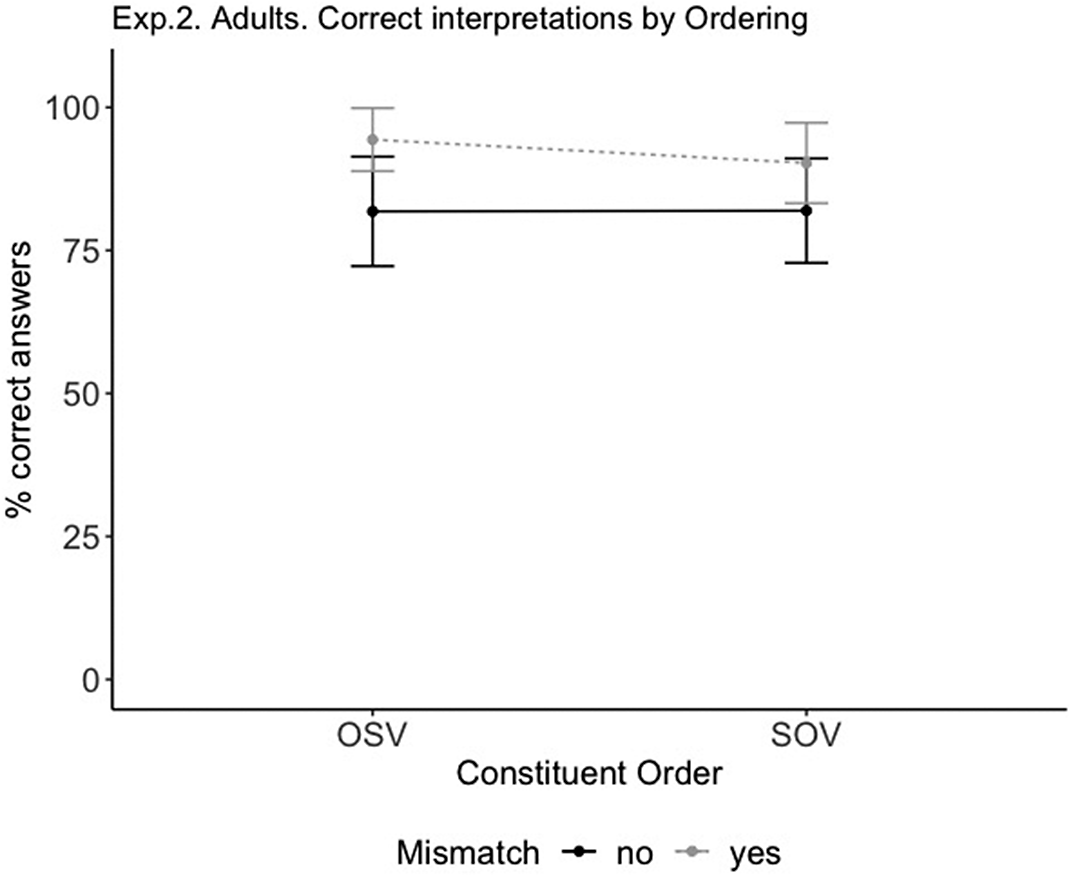
Figure 9. Experiment 2. Adults: Rate of correct judgments in relation to constituent order and number mismatch.
A generalized mixed model, the same used in Experiment 1, was run to assess the effect of Constituent Order and Number Mismatch. Subject and Item were again included as random effects. The model (Table 5) confirmed that Constituent Order has no effect on the probability of providing the correct answer, and that only the effect of Number was significant.
Table 5. Adults. Estimates of the fixed effects of Constituent Order and Mismatch from mixed effect logistic regression fit by maximum likelihood

◦ Correct ~ WO * Mismatch + (1 | Item) + (1 | Subject). AIC = 219.3; BIC = 241.1; LogLik = -103.6, Deviance = 207.3.
These results show that the [+Topic] status of the first constituent, the object, helps to escape intervention and superiority is no longer observed in adults.
Turning to children, the effect of Constituent Order is instead still visible in Figure 7. In absence of a number mismatch, their performance in the SOV conditions is still higher (76.4%) than in the OSV conditions (54.2%) and a number mismatch had the same, rather limited, impact on the proportion of correct answers in both conditions (83.1 % in SOV, 63.4 % in OSV).
A generalized linear mixed model (Table 6) only confirms the main role of Constituent Order, with Number failing to reach statistical significance.
Table 6. Children. Estimates of the fixed effects of Constituent Order and Mismatch from mixed effect logistic regression fit by maximum likelihood

◦ Correct ~ WO * Mismatch + (1 | Item) + (1 | Subject). AIC = 347.5; BIC = 369.4; LogLik = -167.7, Deviance = 335.5.
Children and adults’ performance in Experiment 2 thus seem to diverge in at least two respects. The first, is that a variation of the IS status of the object, now topical, makes the disadvantage of OSV sentence disappear in adults while OSV sentences are still problematic for children; the second, is that the effect of number, detected in Experiment 1, is not significant anymore in the child group, although it is still visible in Figure 10 as a descriptive trend. Therefore, it seems that the manipulation of the IS status of constituents between Experiment 1 and Experiment 2 has had an impact on the ameliorating effect of number in overcoming intervention. In Experiment 2, the interaction between Constituent Order and Mismatch, that made OSV sentences with a number mismatch easier to phrase in Experiment 1, has been absorbed, at least in part, from the [+Topic] status of the fronted object.

Figure 10. Experiment 2. Children: Rate of correct judgments in relation to constituent order and number mismatch.
3.4 Discussion
Experiment 2 shows that the manipulation of the IS status of the fronted object facilitated the correct parsing of OSV sentences in adults. The potential superiority violations in the OS conditions are now avoided if the object is topical. This is in line with similar effects documented in the linguistic literature. Configurations that would violate superiority can be rescued if the object refers to a context set of familiar entities introduced in the discourse (or D-linked in the terms of Pesetsky, Reference Pesetsky, Reuland and ter Meulen1987, Reference Pesetsky2000). In Experiment 2 we document this effect also in Italian, showing that an object associated with a [+topic] grammatical feature is facilitated in crossing the subject, as in OTop SC-Foc sentences.
In children, instead, the effect of topicality is not immediately detectable, at least if the results of Experiment 2 are considered in isolation: the parsing advantage for SOV over OSV sentences is still significant and a [+Topic] feature on the object does not suffice to cancel the structural complexity associated to the OSV configurations. A topic-first kind of bias would not account for the still sharp Subject/Object asymmetry. This, however, does not mean that a [+Topic] feature associated to the fronted object has no impact. To evaluate the effect of the IS status manipulation, we need to compare the results from the two experiments. In doing so, we may look at the SOV and the OSV conditions separately. By comparing the SOV conditions of the two experiments, Figure 11 shows that, in the conditions in which no intervention is expected to arise, little has changed between the two experiments and in both, a number feature mismatch plays a very limited role.

Figure 11. Children’s correct answers in SOV sentences in Experiment 1 and Experiment 2. Match and Mismatch conditions are compared. IS-structure features varied between the two experiments. In Exp.1: Object[+C-foc]; in Exp.2: Object[+top]. Error bars= 2*se.
When the OSV conditions are instead carefully inspected, things change significantly. Figure 12 compares the results of Experiment 1 and 2 with respect to the OSV conditions, i.e. the constituent order in which intervention effects have been detected.

Figure 12. Children’s correct answers in SOV sentences in Experiment 1 and Experiment 2. Match and Mismatch conditions are compared. IS-structure features varied between the two experiments. In Exp.1: Object[+C-foc]; in Exp.2: Object[+top]. Error bars= 2*se.
Figure 12 shows that there is little difference between the two experiments in the mismatch condition: when the subject and object mismatch in their number feature, there is only a small advantage in Experiment 2. The major difference between the two experiments lies instead in the match condition. Here the two constituents only vary in their IS-features and the impact of a different featural make-up of the fronted object becomes evident: in Experiment 2, even in absence of a number mismatch, children’s comprehension of OSV sentences visibly improves. If the object is [+Topic], intervention is ameliorated. Now OSV sentences have an accuracy rate comparable to the conditions with a number mismatch.
In order to assess the role of the manipulation of IS-features between the two experiments, a further generalized mixed effect models was run. This time, three main factors were used as predictors: in addition to Constituent Order (SOV, OSV) and Mismatch (same, different Number) also the IS-features was added to the model (Obj[+Top], Obj[+C-Foc]). The model outcome is reported in Table 7.
Table 7. Children. Estimates of the fixed effects of Constituent Order, Mismatch and Inf.Structure from mixed effect logistic regression fit by maximum likelihood
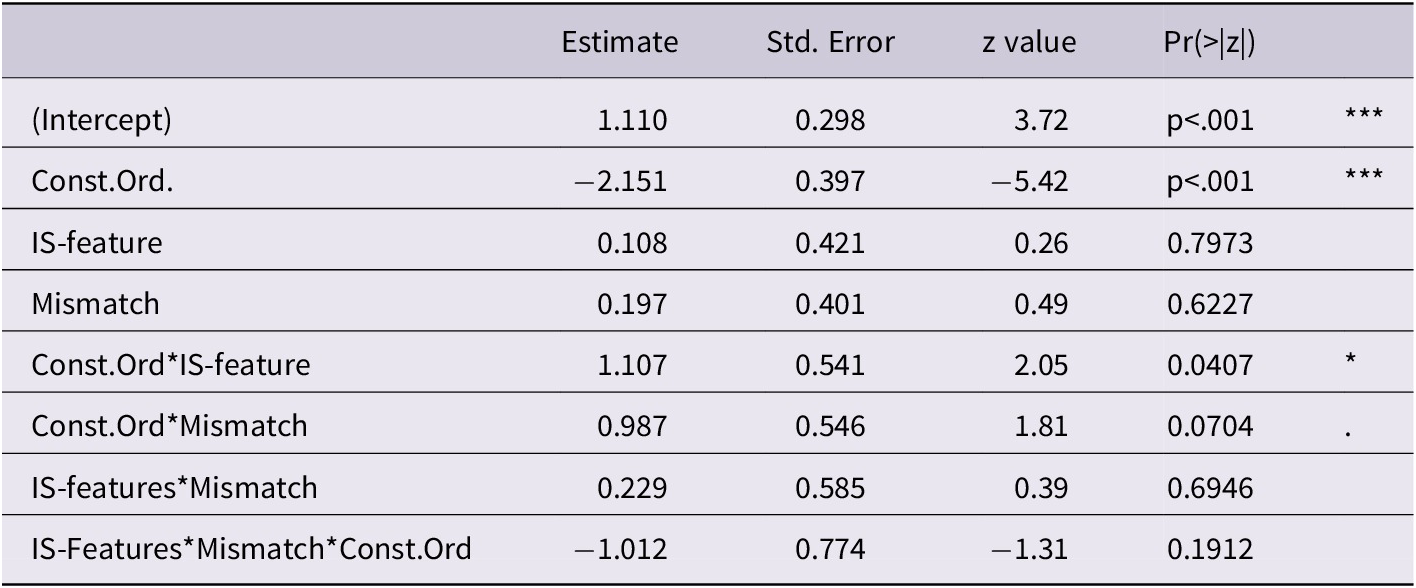
◦ Correct ~ WO * Mismatch + (1 | Item) + (1 | Subject). AIC = 685.1; BIC = 728.5; LogLik = -332.6, Deviance = 665.1.
The analysis confirmed a main effect of Constituent Order, with children’s rate of correct answers being significantly lower in OSV sentences in both experiments. Interestingly, the interaction between Constituent Order and IS-feature was also significant, with more correct answers for the OSV configuration in Experiment 2, when the object carried a [+Topic] feature. The effect of Number Mismatch was instead only marginally significant in interaction with Constituent Order, slightly increasing the probability of correct answers only in the OSV conditions.
Taken together, this not only confirms that OSV orders are the most challenging ones, but also that children start showing a sensitivity to the IS status of the fronted constituents at age 5. The effect of IS-features goes in the same direction of a Number Mismatch and an Object[+Top] is facilitated in crossing a focused subject either when it carried the same or a different number feature from the subject. We also have an indication toward an asymmetry between the IS features associated to the object, since only a [+Topic] feature but not a [+C-Foc] helps in overcoming intervention.
At this point, we should address a residual issue related to the clitic pronoun in the OSV sentences used in Experiment 2. So far we have assumed that low topics do not require to be associated with a clitic pronoun. Therefore, in Experiment 2, a clitic was used only in OTopSFoc sentences: the ones that resulted to be the most problematic for children. This introduced a potential confound related to the presence of the clitic. It is well-known that in Romance languages children go through a stage of clitic omission that lasts until the end of their third year. Also within the same time-window, children had trouble in the past-participle clitic agreement (Moscati & Tedeschi, Reference Moscati and Tedeschi2009; Moscati & Rizzi, Reference Moscati and Rizzi2014). Since the topical object in Experiment 2 was reprised by clitic-doubling, an alternative explanation that should be considered is that children’s difficulties are due to the clitic in OSclV, absent in SOV sentences. These problems have largely disappeared by the age of 5, but we should consider the fact that the presence of clitic in one condition, but not in the other, can provide a different explanation for Experiment 2’s results. This issue is addressed in Experiment 3.
4 Experiment 3
Experiment 3 introduces a minimal variation in the clausal material used in the OS conditions with respect to Experiment 2. In the previous experiment, only sentences with a high topical object presented a clitic pronoun. In Experiment 3, the same stories and the same dialogic structure of Experiment 2 were used. The only difference is in the insertion of a 3rd person clitic pronoun also in the SC-focOTop conditions. Now the object topic is reprised by a co-referring clitic pronoun in both orderings. This minimal variation is illustrated in (19a-b):

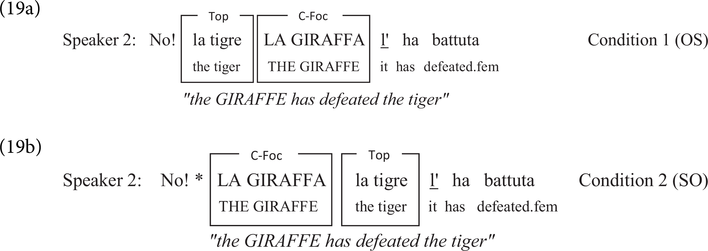
The insertion of the pronoun in (19b), although very minute from the phonological perspective, would allow us to assess the role played by this element in relation to the observed complexity of OS sentences. If the complexity for OS sentences observed in Experiment 2 is increased by the presence of a clitic, we would now expect that both (19a) and (19b) would be problematic. If instead the sentences in Condition 1 are still the hardest, the best explanation for the asymmetry between Condition 1 and Condition 2 is the one based on intervention. Thus, if Experiment 2’s results were determined by the presence of the clitic, the advantage for SO(cl)V sentences should vanish or be at least reduced in children.
As for the grammatical status of sentences illustrated by (19b), the presence of a clitic may be perceived as degraded, at least in comparison to the clitic-less alternative used in Experiment 1 (Belletti, Reference Belletti and Rizzi2004; Samek-Lodovici, Reference Samek-Lodovici2006). This degradation, as pointed out by a reviewer, is not perceived by all Italian speakers but needs to be taken into consideration since it could lead to lower rates of accuracies also in the adult control group. To date, no corpus study is available to determine the incidence of these constructions in child-directed speech. However, if they are marginal for at least some adult speakers, they would occur very rarely in the input provided to children. This also militates against the SOclV structures in (19b): the ones that, on the contrary, are predicted to be favored under an intervention-based account.
4.1 Methods and Material
The same materials of Experiment 2 were used with the only difference that a clitic pronoun was added also to all SOV sentences resulting in a SOclV as in (19b) (see Supplementary material, Appendix C for the full list of test sentences).
4.2 Participants
20 children (M= 5;7. Range 5;1 – 6;1) and 14 adults between 24 and 30 y.o were recruited in the same area of Experiment 1 and 2. None of them took part in the previous experiments.
4.3 Results
Two children were excluded on the basis of their poor performance in the warm-up session, using the same criteria adopted in the two previous experiments. We report the results of the remaining 18 children. Once again, participants in both groups had no problem in judging SVO sentences (Figure 13).

Figure 13. Experiment 3. Proportion of correct judgments for Control SVO sentences in the adult and in the child group.
Let us consider now the role played by the clitic pronoun in the SOclV sentences, starting from the adult control group. Their proportion of correct answers in the four experimental conditions is reported in Figure 14. The presence of a clitic in SOclV sentences led to a lower performance with respect to SOV sentences in Experiment 2. The rate of correct answers now dropped to a low 42.8% in the match condition. In OSclV sentences instead, where the presence of the clitic is the only option and intervention is defused by the topical status of the fronted object, adults’ performance reaches 91.1%. As observed in the previous experiments, the extra cues provided by the introduction of a feature mismatch cancelled any difficulty, raising adults’ performance almost at ceiling for each constituent ordering.

Figure 14. Experiment 3. Adults: Rate of correct judgments in relation to word order and number mismatch.
A generalized mixed model was run to assess the role of Constituent Order and Mismatch, reveling that only Constituent Order was significant, but this time with the probability of providing the correct answer being higher in the OSclV condition, the one in which the presence of the clitic is not optional. The interaction between Constituent Order and Mismatch was also significant, with the effect of mismatch ameliorating judgments in SOclV sentences (Table 8).
Table 8. Adults. Estimates of the fixed effects of Constituent Order and Mismatch from mixed effect logistic regression fit by maximum likelihood

◦ Correct ~ WO * Mismatch + (1 | Item) + (1 | Subject). AIC = 435.9; BIC = 456.4; LogLik = -211.9, Deviance = 423.9.
Turning to children, their answer’s pattern is very different from the adult one: SOclV sentences still present a higher rate of correct answers than OSclV sentences, despite the presence of the clitic. A feature mismatch only slightly increases children’s performance, as shown in Figure 15.

Figure 15. Experiment 3. Children: Rate of correct judgments in relation to word order and number mismatch.
The effect of Constituent Order was still significant (p<0.01) but the direction of the effect is the inverse than in the adult controls: the probability of providing the right answer is higher in the SOclV Conditions as in Experiment 1 and 2. The effect of Mismatch does not instead reach statistical significance (Table 9).
Table 9. Children. Estimates of the fixed effects of Constituent Order and Mismatch from mixed effect logistic regression fit by maximum likelihood

◦ Correct ~ WO * Mismatch + (1 | Item) + (1 | Subject). AIC = 547.0; BIC = 568.9; LogLik = -267.5, Deviance = 535.0.
The introduction of a clitic thus does not seem to create additional troubles for children in SOclV sentences and children’s overall performance is similar in Experiment 2 and 3. This can be observed by comparing the percentage of correct answers in the two experiments reported in Figure 16.

Figure 16. Children’s correct answers for Constituent Orders in Experiment 2 and Experiment 3 with the same number. The only difference between the two experiment is in the materials used SOV condition: the insertion of a clitic in Experiment 3, resulting in the SOTopclV. Error bars= 2*se
Again, a generalized mixed-model was run on the same number conditions in Experiment 2 and Experiment 3. Constituent-order and Presence-of-Clitic were used as predictors. The model (Table 10) shows that only the main effect of constituent order was significant. This confirms that the presence of the clitic does not impact negatively children’s ability to correctly interpret the target sentences and the problems they encounter with fully grammatical OSclV sentences in Experiment 2 cannot be reduced to problems with the pronoun.
Table 10. Estimates of the fixed effects of Constituent Order and Experiment from mixed effect logistic regression fit by maximum likelihood

◦ Correct ~ WO * Experiment + (1 | Item) + (1 | Subject). AIC = 346.5; BIC = 368.5; LogLik = −167.3, Deviance = 334.5
5 General Discussion and Conclusions
This paper addressed, through a series of three experiments, the constraints that may initially disfavor or even block the successful parsing of non-canonical sentences with two fronted constituents. Inspired by some initial observations on spontaneous production, mostly coming from the data presented in Soares (Reference Soares2006) for Portuguese and Moscati and Rizzi (Reference Moscati and Rizzi2021) for Italian, we explored a potential subject/object asymmetry on multiple extractions, favoring representations in which the subject is moved across the object. This is reminiscent of the classical observation of superiority: it can be subsumed under a featural relativized minimality approach (see Rizzi, Reference Rizzi2018, for a recent overview) integrated by the proposal that only nested chains count as interveners (Krapova & Cinque, Reference Krapova and Cinque2008). The experimental results presented here show that in configurations with two sentence-initial DPs, five-year-old children generally disfavor interpretations consistent with the OSV word-order. Turning back and reconsidering spontaneous production, all documented occurrences in Soares (Reference Soares2006) and Moscati and Rizzi (Reference Moscati and Rizzi2021) invariably present SOV sequences in which a Topical subject precedes a dislocated object: spontaneous production and comprehension thus render a coherent picture, indicating that multiple dislocations resulting in OSV sequences are initially problematic for children.
As for the reasons for this observed pattern, a viable hypothesis is that the problematic configurations can be reconducted to a similar kind of intervention effects documented with children’s interpretation of object A-bar dependencies. An indication in this sense comes from the fact that such effects are modulated by the degree of the featural overlap between constituents. Looking at Hebrew-speaking children, Friedmann et al. (Reference Friedmann, Belletti and Rizzi2009) found that children experienced most of their difficulties with sentences like (20) and (21):
In the sentences above, the featural make-up of the moved objects (i.e. the elephant, which dog) overlaps with the grammatical features of the subject: both constituents carry a lexical restriction (+N) and have the same number (+sing). However, once the two constituents are differentiated in terms of number, intervention effects became milder and the comprehension of sentences as (22) is facilitated with respect to (21):
The facilitatory effect of a number mismatch has been variously documented not only in children (Arosio et al., Reference Arosio, Adani, Guasti, Brucart, Gavarró and Solà2009; Adani et al., Reference Adani, van der Lely, Forgiarini and Guasti2010; Bentea & Durrleman Reference Bentea, Durrleman, Bril, Coene, Ihsane, Sleeman and Westveer2022) but also in adults if more sensitive on-line measures are employed, as in the self-paced reading study reported in Biondo et al. (Reference Biondo, Pagliarini, Moscati, Rizzi and Belletti2022). The results presented in this paper are in line with these previous observations. In fact, difficulties with configurations in which intervention arises are, at least in part, circumvented if DP1 and DP2 are differentiated in terms of their number feature, as shown in Experiment 1.
A question that naturally arises is about the array of syntactic features that might help to differentiate the two constituents. In order to answer this question, IS-features were also manipulated between Experiment 1 and Experiment 2. By comparing the results of Experiment 1 and 2, the effect of a [+Topic] feature associated to the object ameliorated the comprehension of OSV sentences.
In light of this results, we may also reconsider spontaneous production data. At age two, in production, a IS-feature mismatch does not seem to be able to allow an Object[+Top] to cross a Wh- subject, despite their clear differentiation in terms of their feature make-up. We may conjecture that children develop a gradual sensitivity to the grammatical features that allow to avoid intervention. When very young, they might be extremely rigid in their avoidance of nested chains, systematically disfavoring OSV sequences. Later on, and by the age of five, they become sensitive to fine-grained featural differences. Among them, i. to the number distinctions that are visible in Experiment 1 and in previous literature on object relatives, and ii. to the [+Topic] feature as shown by comparing Experiment 1 and Experiment 2Footnote 6.
As a concluding remark, I wish to consider some consequences on the learnability of the layered left-periphery of Italian, stemming from the claim that at a very early stage, children only have full access to SOV structures. This has been captured here through the generalization in (6), that expresses a bias in favor of interpretations that better align to the canonical word order (SVO) in which the first constituent is the subject. I proposed here a representational approach to account for this generalization based on the nested/crossed chains distinction. In fact, only nested chains would reverse the unmarked word order.
This is compatible, and might even be conceived as an emergent property, of an earlier parsing bias that led children toward an initial commitment on the grammatical function of the first DP. Subject-first (see Aravind et al., Reference Aravind, Hackl and Wexler2018) or agent-first (Huang et al., Reference Huang, Zheng, Meng and Snedeker2013) heuristic would both militate in this direction, favoring SOV interpretations represented through crossed-chains dependencies. In any case, we observe here a gap between the set of structures that are potentially available in the input - both SOV and OSV sentences - and children’s intake that would filter out OSV sentences. This linking problem, discussed in Omaki and Lidz (Reference Omaki and Lidz2015), raises at least two questions.
The first is about the early development of the Italian Left-Periphery. Moscati and Rizzi (Reference Moscati and Rizzi2021) showed that Italian-speaking children have converged on a layered representation already from the age of 2. How could they have achieved this quite remarkable result with a restricted access to the input data? Constructions with a single fronted constituent (e.g. Wh-questions or Topic-fronting) would only inform children that a single left-peripheral syntactic position is available. On the contrary, sentences with the overt dislocation of two constituents, as the ones investigated here, carry the crucial information that would force children to expand their clausal representation into a more articulated left-periphery. But not all sentences with double dislocations are accessible to children. A crucial interrogative is whether SOV sentences alone are sufficient to converge on an satisfactorily first approximation of the layered structure of the Italian clauses.
The answer to this question seems to be affirmative, since OSV constructions, the ones that may be not correctly represented in children’s intake, are somehow less informative than SOV. In OSV sentences, the subject-verb cluster (SV) is still the same as in the canonical (SV)O sentences. Therefore, the problematic O(SV) sentences would only inform children that the canonical VO cluster is broken: they provide unambiguous evidence on the dislocation of a single constituent, the object. These constructions are quite uninformative on the possibility to left-dislocate also the subject, since if subject movement occurs, it would be string-vacuous.
SOV sentences, instead, are more transparent. Here both the (SV) and the (VO) clusters found in canonical SVO sentences are broken: the object does not sit in its postverbal position (OV instead of VO); moreover, also the subject is visibly moved so as to immediately precede the object (SO instead of SV). Hence, the SOV configuration is, at the same time, the more informative and also the easier to parse for young children. Under this view, sentences like S Wh V can be considered as the primary triggers that allow children to correctly hypothesize the expanded left-periphery of languages of the Italian kind. In this respect, sentences with multiple movements shouldn’t be treated as marginal constructions, but instead a key primary source of informative data.
The second question is on what triggers the proper analysis of OSV sequences, leading to a fully adult-like representation of the left-periphery. This question did already receive an answer, under an intervention-based account. In fact, nested chains may become unproblematic, as they are for adults, once children fully consider the entire feature-set associated to the dislocated constituents as number or IS-features. Taken together, the results presented here render a substantial continuity in development between 2- to 5-year-olds, and later into adulthood.
As a concluding remark, it is worth pointing out that this study also raises a new series of questions about children’s sensitivity to the grammatical features that help avoiding intervention. In this respect, the distinction between active and inactive features may be still too coarse to capture children’s sequential development of A-bar movement in configurations where intervention might block it. There are differences between the kinds of active IS-features, as topic or contrastive focus, that can modulate intervention effects at different stages. In this respect, more work is needed to assess if single features could be broken up and considered in relation to other additional factors such as, for example, their encoding into overt morphology or their optionality to trigger movement, that would determine their staggered entrance within the active set of grammatical features that overcome intervention.
Supplementary material
The supplementary material for this article can be found at http://doi.org/10.1017/S0305000923000508.
Acknowledgements
I wish to thank Luigi Rizzi and Adriana Belletti for their comments and the many helpful discussions we had at different stages of this project. My thanks also go to Camilla Covazzi, for her help in collecting preliminary pilot data for Experiment 3.
Competing interest
The author declares none.































